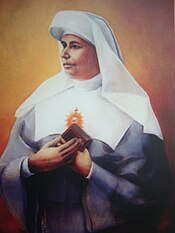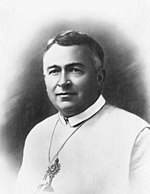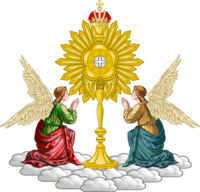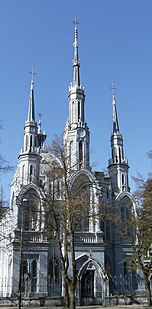|
Mariavite Church
The Old Catholic Mariavite Church refers to one of two independent Christian churches, both of which can be dated from 1906 but which became distinct after 1935 as a result of doctrinal differences, and are collectively known as Mariavites. Mariavitism first emerged from the religious inspiration of Polish noblewoman and nun Feliksa Kozłowska (1862–1921) living in the Russian Partition of Poland in the late 19th-century. A young Catholic priest from a modest background, Jan Maria Michał Kowalski (1871–1942), became convinced by Kozłowska's revelations and adopted her vision as his own project by her side. The movement represented an ideology whose aim was to imitate the simplicity of the life of Mary, in Latin, qui Mariae vitam imitantur, ("Let them imitate the Life of Mary"), thus vita Mariae, the Life of Mary, gave the movement its name. The movement became the subject of two Papal bulls in 1906 which resulted in the mass excommunication from the Catholic Church of both clergy and lay adherents to the movement. The leaders of the movement sought theological sanctuary with the Old Catholic Church of the Netherlands which, after negotiations welcomed them and in 1909 granted both recognition and Apostolic succession to what by default had become a new catholic church, the "Mariavite Church", with the power to confer holy orders. It therefore became a separate and independent religious denomination in Poland.[2] It continued as a unitary church until 1935 when a faction led by bishop Filip Feldman challenged the church leader, Michał Kowalski, and successfully expelled him and his loyalists from the headquarters in the Polish city of Płock, thereby creating two Mariavite churches. HistoryPolish Roman Catholic Church under Russian rule From 1795 the territory of the Polish–Lithuanian Commonwealth had been partitioned between the three neighbouring powers, the Austrian Empire, the Kingdom of Prussia and the Russian Empire. Under the Russian Empire, where the Russian Orthodox Church was the established church, Polish Catholic religious organizations became illegal. The situation of the Catholic Church was worst in the Russian Partition. After the 1863 January Uprising, the tsarist authorities forbade the establishment of any new Polish organisations. Religious orders were often banned or exiled. Catholic clergy in the Russian Partition could not be locally educated, in contrast to the priests in the Austrian and Prussian Partitions. The only authorized Roman Catholic theological training in the Russian Empire was at the Saint Petersburg Roman Catholic Theological Academy. Kozłowska's revelationsIn 1893 Kozłowska had her first religious vision. In it she understood she was to found a new religious movement expressing "Mariavitism". Further visions continued until 1918. Their content was gathered in a volume entitled Dzieło Wielkiego Miłosierdzia (The Work of Great Mercy), published by the Marinate Press in 1922. ExcommunicationObserving the spread of "Mariavitism" across their ecclesiastical territory, Polish Catholic bishops were alarmed by the threat the movement posed to their apostolic authority and teachings and reported it to the Vatican probably in the late 1890s. After the election of a new pope, a final papal decision on the fate of the movement was made in September 1904.[3] In April 1906, Pope Pius X promulgated the encyclical Tribus circiter.[3] In December 1906, the Catholic Church excommunicated Kozłowska, Kowalski and their followers.[3] Mariavite Church, 1906–1921From 1906 the newly independent denomination continued its development, in no small measure due to donations and support from the faithful. Kozlowska's own acquisition of 400 hectares of land in Płock, enabled not only the construction of a cathedral, completed "in-house" by two professionally qualified architects and engineers (Maria Mateusz Szymanowski and Maria Bartłomiej Przysiecki) who brought into the church considerable personal 'dowries' for the construction in Płock, of the Sanctuary of Mercy and Charity(1914) with adjoining monastic buildings,[4] but the development of revenue raising enterprises, such as educational facilities, a printing press, bakery and animal breeding. Temple of Mercy and Charity (1914) in Płock, Poland, headquarters of the Old Catholic Mariavite Church. The complex in English Gothic was designed by Feliks Maria Mateusz Szymanowski and Maria Bartłomiej Przysiecki, later priests of the church, with Michał Kowalski as client Apostolic successionKowalski was consecrated in St. Gertrude's Cathedral, Utrecht, on 5 October 1909, by Old Catholic Church of the Netherlands (OKKN) Archbishop Gerardus Gul of Utrecht, assisted by two OKKN bishops, J. J. van Thiel of Haarlem and N. B. P. Spit of Deventer, one Catholic Diocese of the Old Catholics in Germany bishop, J. Demmel of Bonn, and Arnold Harris Mathew of London.[5] In turn, Kowalski went on to consecrate: Fatôme (France), Feldman, Gołębiowski, Próchniewiski, Rostoworowski, Siedlecki, and his own wife, Maria Izabela Wiłucka-Kowalska.[6] Kowalski reforms (1921–1935) Following the death in 1921 of the foundress of the movement, Kozlowska, there was no effective inhibition on Kowalski's reforms and innovations which included:
Kowalski's innovations disrupted and severed the connection with the Old Catholics in Europe.[8] The church struggled to maintain its reputation and standing during the Second Polish Republic in newly independent and sovereign Poland. Mariavites were actively discriminated against to the extent of "Mariavite pogroms". The leaders of the Mariavite Church were persecuted and sued in court. Kowalski himself appeared in 20 cases to answer charges. Among other allegations he was accused of blasphemies.[9] Church schism![Bishop Maria Filip Feldman [pl] (1885-1971)](http://upload.wikimedia.org/wikipedia/commons/thumb/5/51/Biskup_Klemens_Maria_Filip_Feldman.png/150px-Biskup_Klemens_Maria_Filip_Feldman.png) Throughout its early tribulations with the Rome authorities, the church was led by Kozłowska's lieutenant, the catholic priest, later excommunicated, Michał Kowalski until 1935. Kowalski had become a bishop and archbishop in the meanwhile, headquartered in the city of Płock, among other Mariavite diocesan bishops. His theological, doctrinal and ecclesiastical interpretations and innovations put pressure on the Mariavite episcopate. Among these were the introduction of married clergy, the subsequent birth of 'mystical children' separated from their parents for early rearing, the ordination of women, the establishment of a "priesthood of the faithful" and not least, Kowalski's own sexually predatory and abusive behaviour towards young nuns. The sexual allegations became the subject of a court case and public scandal surrounding the church and its reputation. Kowalski's brother bishops decided to put a stop to Kowalski's term of office and a schism ensued. The church split in two, so that the "Kowalski parishes", in the minority, became the "Catholic Mariavite Church". Its headquarters was moved to the small estate of Felicjanów, named in honour of the foundress. The dissident majority became known as the "Old Catholic Church of the Mariavites", which, after 1935, was led by bishop Maria Filip Feldman and remained based in the city of Płock. To this day, by reason of the number of worshippers and parishes, they are the larger of the two churches. After 1935, the leadership of the smaller church grouping, the Catholic Mariavite Church, remained loyal to bishop Kowalski, and after his death in a Nazi concentration camp to his widow, bishop Maria Izabela Wiłucka-Kowalska.[2] The Old Catholic Mariavite Church remains a member of the Polish Ecumenical Council, and also of the World Council of Churches. It is not currently a member of the Old Catholic Union of Utrecht. Since 2023, Maria Jan Opala is the primate bishop of the Old Catholic Mariavite Church. By contrast, the Catholic Mariavite Church currently stands away from the ecumenical movement. Polish name changesThe original name of the church was in English translation, the "Old Catholic Mariavite Church" (Polish: Staro-Katolicki Kościół Mariawitów) between 1910 and 1967, when it became Kościół Starokatolicki Mariawitów a grammatical change which does not affect the translation into English.[10][11] After the 1935 schismThe Kowalski loyalists moved from Płock to Felicjanów. The village is the headquarters of the Catholic Church of the Mariavites, which has about 3,000 members. The denomination confirmed all the decisions of Kowalski and introduced a public cult of Kozłowska, the Mateczka, the Spouse of Christ and new Redemptrix of the world. The church is insular and does not participate in the ecumenical movement. Kowalski died in Dachau concentration camp during World War II. His successor was his wife, Bishop Maria Izabela Wiłucka-Kowalska. From 1946 to 2005, the head of the church was Bishop Maria Rafael Wojciechowski. He was succeeded in 2005 by Bishop Maria Beatrycze Szulgowicz. Feldman led the opposition to Kowalski and attracted the majority of Mariavite adherents. They decided to reverse most of the innovations introduced by Kowalski. They returned to Kozłowska's ideas and rules. The Old Catholic Mariavite Church is much the larger: as of 2011[update] it had about 23,500 members in Poland.[12] Structure of the Mariavite churchOld Catholic Mariavite ChurchLeaders:
Administration:  organized into three dioceses in Poland with 38 parishes and one province in France with 2 parishes:
Order of Mariavites in GermanyThe Order of the Mariavites in Germany (German: Orden der Mariaviten in Deutschland e.V.) is an Eingetragener Verein type association in Germany. Even in 1949, this association was not legally recognized as a sect by Germany.[14] Apostolic succession:
Notes
References
Sources
Further reading
External linksWikimedia Commons has media related to Mariavite Church. |
||||||||||||||||||||||||||||||||||||||||
Portal di Ensiklopedia Dunia


